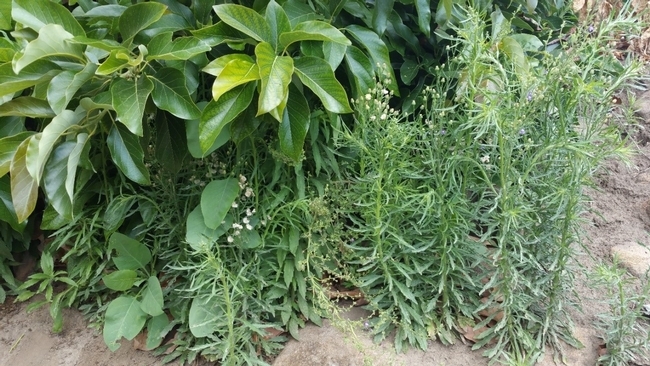A recent call about the poor control of marestail (horseweed, Conyza canadensis) to glyphosate (Roundup®) wasn't surprising, but that paraquat didnt do the trick was. It turns out that there is multiple resistance to the materials. If horseweed is resistant to glyphosate it is possibly going to be resistant to paraguat which also means that hairy fleabane which has glyphosate resistance could also show resistance to paraquat. A recent study reports on the increased Conyza resistance to paraquat (Distribution of Conyza sp. in Orchards of California and Response to Glyphosate and Paraquat, Moretti et al, https://doi.org/10.1614/WS-D-15-00174.1):
Resistance to glyphosate in hairy fleabane and horseweed is a problem in orchards and vineyards in California. Population genetic analyses suggest that glyphosate resistance evolved multiple times in both species, but it is unknown if resistance to other herbicides is also present. Two approaches of research were undertaken to further evaluate herbicide resistance in Conyza sp. in the perennial crop systems of California. In the initial study, the distribution of Conyza sp. in the Central Valley, using a semistructured field survey, was coupled with evaluation of the presence and level of glyphosate resistance in plants grown from field-collected seed. In a subsequent study, single-seed descendants representing distinct genetic groups were self-pollinated in the greenhouse and these accessions were evaluated for response to glyphosate and paraquat. Conyza sp. were commonly found throughout the Central Valley and glyphosate-resistant individuals were confirmed in all field collections of both species. The level of glyphosate resistance among field collections varied from 5- to 21-fold compared with 50% glyphosate resistance (GR50) of the susceptible, with exception of one region with a GR50 similar to the susceptible. When self-pollinated accessions from different genetic groups were screened, the level of glyphosate resistance, on the basis of GR50 values, ranged from 1.7- to 42.5-fold in hairy fleabane, and 5.9- to 40.3-fold in horseweed. Three accessions of hairy fleabane from different genetic groups were also resistant to paraquat (40.1- to 352.5-fold). One glyphosate-resistant horseweed accession was resistant to paraquat (322.8-fold), which is the first confirmed case in California. All paraquat-resistant accessions of Conyza sp. identified so far have also been resistant to glyphosate, probably because glyphosate resistance is already widespread in the state. Because glyphosate and paraquat resistances are found across a wide geographical range and in accessions from distinct genetic groups, multiple resistant Conyza sp. likely developed independently several times in California.
